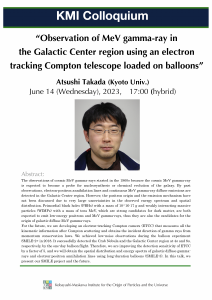Observation of MeV gamma-ray in the Galactic Center region using an electron tracking Compton telescope loaded on balloons
“KMI colloquium” 14th June (Wed) 17:00 –
Speaker: Dr. Atsushi Takada (Kyoto Univ.)
Title: Observation of MeV gamma-ray in the Galactic Center region using an electron tracking Compton telescope loaded on balloons
Place: ES635& ZOOM
The observations of cosmic MeV gamma-rays started in the 1960s because the cosmic MeV gamma-ray is expected to become a probe for nucleosynthesis or chemical evolution of the galaxy. By past observations, electron-positron annihilation lines and continuous MeV gamma-ray diffuse emissions are detected in the Galactic Center region. However, the positron origin and the emission mechanism have not been discussed due to very large uncertainties in the observed energy spectrum and spatial distribution. Primordial black holes (PBHs) with a mass of 10^16-17 g and weakly interacting massive particles (WIMPs) with a mass of tens MeV, which are strong candidates for dark matter, are both expected to emit low-energy positrons and MeV gamma-rays, thus they are also the candidates for the origin of galactic diffuse MeV gamma-rays.
For the future, we are developing an electron-tracking Compton camera (ETCC) that measures all the kinematic information after Compton scattering and obtains the incident direction of gamma rays from momentum conservation laws. We achieved low-noise observations during the balloon experiment SMILE-2+ in 2018. It successfully detected the Crab Nebula and the Galactic Center region at 4σ and 8σ, respectively, by the one-day balloon flight. Therefore, we are improving the detection sensitivity of ETCC by a factor of 5, and we will obtain the spatial distribution and energy spectra of galactic diffuse gamma-rays and electron-positron annihilation lines using long-duration balloons (SMILE-3). In this talk, we present our SMILE project and the future.




